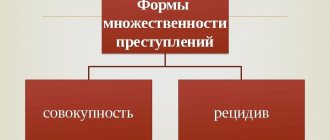ST 17 of the Criminal Code of the Russian Federation.
1. A set of crimes is the commission of two or more crimes, for none of which a person has been convicted, except for cases where the commission of two or more crimes is provided for by the articles of the Special Part of this Code as a circumstance entailing a more severe punishment. In case of aggregation of crimes, a person bears criminal liability for each crime committed under the relevant article or part of an article of this Code.
2. One action (inaction) containing signs of crimes provided for by two or more articles of this Code is also recognized as a set of crimes.
3. If a crime is provided for by general and special norms, there is no totality of crimes and criminal liability arises according to the special norm.
Aggregate - a type of multiplicity of crimes
Multiplicity of crimes is the commission by one person of two or more socially dangerous acts, each of which contains all the signs of specific crimes.
The Criminal Code of the Russian Federation does not contain the concept of plurality. Plurality of crimes consists of two or more crimes that retain criminal legal consequences. The Criminal Code distinguishes two types of multiplicity of crimes:
1) totality (Article 17 of the Criminal Code of the Russian Federation);
2) relapse (Article 18 of the Criminal Code of the Russian Federation).
Aggregate crimes - the commission of two or more crimes, for none of which the person was convicted, except for cases where the commission of two or more crimes is provided for in the articles of the Special Part of the Criminal Code as a circumstance entailing a more severe punishment.
In case of aggregation of crimes, a person bears criminal liability for each crime committed under the relevant article or part of an article of the Criminal Code of the Russian Federation.
Types in criminal law
What types are there? The Criminal Code of the Russian Federation does not contain information on the division of the totality of crimes into certain types. In judicial practice, this concept is usually divided into real and ideal forms.
Each of these types of crimes has certain features that are taken into account when assigning punishment. The need to highlight these forms is determined by criminal practice.
In the process of committing a crime, a citizen can commit a number of socially dangerous acts or one offense, but with several consequences that have elements of individual crimes.
Real
A real set of crimes is characterized by two or more socially dangerous acts, each of which has the characteristics of an independent crime.
The nature of crimes can be identical, heterogeneous or homogeneous.
The number of crimes in a real population is equal to the number of offenses.
For example, if a citizen committed three acts, then three facts of illegal acts will be taken into account. The time intervals between crimes do not matter.
Examples:
- several thefts (identical nature of the crime);
- theft and hooliganism (various types of acts);
- extortion and robbery (homogeneous meanings of crimes).
An example of a situation involving a real set of crimes is the arson of a premises in order to hide traces of a murder in combination with the deprivation of life of third parties.
In this case, there are three actions and three components of socially dangerous acts - arson of a premises, murder and causing harm of varying degrees of severity to bystanders.
All crimes will be taken into account when determining punishment. Based on the actual totality, the most severe punishments and long terms of imprisonment are assigned.
Perfect
An ideal set of crimes is established when one socially dangerous act has signs of several crimes, which are contained and regulated by different criminal law norms.
This concept should be distinguished from consistent illegal actions.
For example, if as a result of an attack (with a fatal outcome) on a specific victim, third parties were injured, then such a crime has several elements - murder and causing harm to health of varying degrees of severity.
Examples:
- robbery combined with causing grievous bodily harm;
- causing death in the course of a robbery.
Examples of an ideal set of crimes are setting fire to a premises with the aim of killing a specific citizen or causing death as a result of robbery and violent acts.
What unites these situations is the goal of taking a person’s life. The ways to achieve results are different.
In both cases, the offender commits socially dangerous acts that have independent elements of crime.
General signs of a set of crimes:
- two or more crimes have been committed (the independence of crimes is evidenced by such circumstances as their different objective side, the absence of a single intent to commit similar actions, different objects of encroachment);
- one of the crimes is not a sign of another crime . The commission of one act by a person, characterized by several elements of a crime provided for by various parts or paragraphs of one part of one article of the Criminal Code of the Russian Federation, does not form a set of crimes. Thus, the commission of theft with illegal entry into a home (clause “a”, part 3, article 158 of the Criminal Code of the Russian Federation) on an especially large scale (clause “b”, part 4, article 158 of the Criminal Code of the Russian Federation) does not form a set of crimes;
- all crimes retained legal consequences (for the totality, it is necessary that for each of the crimes the possibility of criminal prosecution is retained. Firstly, a person should not be subject to exemption from criminal liability due to the expiration of the statute of limitations; secondly, the acts at the time of prosecution liability is not decriminalized; thirdly, criminal prosecution for the commission of these crimes should not be terminated by virtue of an amnesty act. If at least one of these conditions is present, then the committed acts cannot be recognized as a totality);
- the person was not convicted for any of them , i.e. no conviction was made against him (what matters is not the moment the previous sentence entered into legal force, but the time of its passing. Consequently, the totality of crimes takes place both before the person is convicted of committing a crime, and after, and not before the sentence comes into legal force );
- the crimes committed are not provided for by the articles of the Special Part of the Criminal Code of the Russian Federation as a circumstance entailing a more severe punishment (for example, the infliction of grievous harm to health (Article 111 of the Criminal Code of the Russian Federation), which entailed causing death by negligence to the victim, does not form a set of crimes, although causing death by negligence is provided for independently Article 109 of the Criminal Code of the Russian Federation. In this case, causing death by negligence is a circumstance entailing a more severe punishment, which excludes the presence of a set of crimes).
The presence of a set of crimes is also recognized in the following cases:
1) one crime is completed, and another, identical criminal act is interrupted at the stage of preparation or attempt (for example, in one case the theft is completed, in the other there was an attempted theft);
2) in one crime a person acts as a perpetrator, and in another - an organizer, instigator or accomplice.
Second commentary to Art. 17 of the Criminal Code of the Russian Federation
1. The set of crimes is characterized by the following characteristics:
- two or more crimes have been committed;
- none of the crimes is a sign of another crime and (or) is not provided for in the articles of the Special Part of the Criminal Code as a circumstance entailing a more severe punishment;
- at least two of the crimes retained legal consequences;
- the person was not convicted of any of the crimes.
2. A set can be formed by identical, homogeneous or heterogeneous crimes committed simultaneously or sequentially.
A set of crimes is formed when acts provided for by one or different articles of the Special Part of the Criminal Code are committed.
3. In the theory of criminal law and judicial practice, two types of totality are distinguished - real and ideal.
The totality is recognized as real when a person commits two or more crimes under different articles, parts of an article of the Criminal Code or one article (part of an article) of the Criminal Code at different times by different independent actions. For example, the culprit commits theft (Part 1 of Article 158 of the Criminal Code), and after some time high treason (Article 275 of the Criminal Code).
The real totality of crimes must be distinguished from the competition of criminal law norms, which means that the same criminal act falls under the characteristics of two or more criminal law norms, for example, general and special or two special norms. If a crime is provided for by general and special norms, there is no totality of crimes and criminal liability arises according to the special norm (Part 3 of Article 17 of the Criminal Code). There is no totality of crimes even when there are special norms in competition.
In this case, the actions of the perpetrator are qualified only according to the norm that most fully covers the criminal offense and has a large number of special characteristics.
4. In part 2 of Art. 17 of the Criminal Code formulates an ideal set. It is understood as the commission of one action (inaction) containing signs of crimes provided for by two or more articles of the Criminal Code. Its distinctive feature is that the perpetrator commits one act that causes harm to different objects of the crime. For example, stealing a car with the aim of taking possession of the property in it.
The ideal and real set of crimes have the same criminal legal significance.
The totality consists of both identical and heterogeneous crimes
When aggregated, the perpetrator simultaneously or sequentially commits several crimes. The totality can be formed by various types of crimes:
- identical (for example, the culprit first committed a theft in a store (Article 158 of the Criminal Code of the Russian Federation), and then another theft in another store);
- homogeneous (for example, the culprit committed robbery (Article 161 of the Criminal Code of the Russian Federation), and then robbery (Article 162 of the Criminal Code of the Russian Federation));
- heterogeneous (for example, the culprit violated the rules of the road and the operation of vehicles (Article 264 of the Criminal Code of the Russian Federation) and left the victim in danger (Article 125 of the Criminal Code of the Russian Federation)).
Real and ideal set of crimes
A set of crimes can form crimes committed by one or different actions, either at different times or simultaneously. In this regard, two types of aggregate crimes are distinguished: real and ideal aggregate.
Real totality of crimes
The totality is recognized as real when a person commits two or more crimes under different articles or parts of an article of the Criminal Code at different times by different independent acts. For example, the perpetrator commits murder (Article 105 of the Criminal Code of the Russian Federation), and then after some time commits robbery (Article 162 of the Criminal Code of the Russian Federation). In a real totality, there is a period of time between crimes (it doesn’t matter whether it’s long or short). One of them in relation to the other will always be the first in terms of the time of its commission. At the same time, in relation to the first (subsequent) crime, the statute of limitations for bringing to criminal liability must not expire (Article 78 of the Criminal Code of the Russian Federation). For example, committing a premeditated murder after the end of a violent sexual act or an attempt on it in order to conceal the crime committed forms a set of relevant crimes (clause 13 of the Resolution of the Plenum of the Supreme Court of the Russian Federation of January 27, 1999 N 1 “On judicial practice in cases of murder (Article 105 Criminal Code of the Russian Federation)").
The time of commission of two or more crimes may completely coincide. Thus, the simultaneous illegal possession of weapons and drugs forms a real set of crimes, since at the time of the commission of one ongoing crime, another is committed, and both crimes continue to be committed until the state of storage ceases. The presence of a real aggregate in this case is due to the fact that outwardly almost identical storage actions are still different, since they are performed independently in relation to each item of storage. Another example: a person commits desertion (Article 338 of the Criminal Code of the Russian Federation) and at the same time illegally possesses weapons (Article 222 of the Criminal Code of the Russian Federation).
Thus, the real population is characterized by the following features:
- committing two or more independent crimes within a certain time interval;
- the person was not convicted for their commission;
- for their commission, criminal prosecution is possible (the statute of limitations for criminal prosecution has not expired, there is no act of amnesty, etc.).
The real totality consists of both completed crimes and preparation or attempted crime, as well as crimes committed in complicity.
Examples of qualification of acts as a real set of crimes
Theft and theft . If a person steals a vehicle without the purpose of stealing it (Article 166 of the Criminal Code of the Russian Federation) and at the same time steals the property located in it, the act constitutes a set of crimes providing for liability for theft and theft (clause 22 of the Resolution of the Plenum of the Armed Forces of the Russian Federation dated 09.12.2008 N 25 “On judicial practice in cases of crimes related to violation of traffic rules and operation of vehicles, as well as their unlawful taking without the purpose of theft”).
Extortion and robbery (robbery) . If extortion is associated with the direct seizure of the victim’s property, then if there is a real set of crimes, the crime is qualified under Art. Art. 163 and 161 or under Art. 162 of the Criminal Code of the Russian Federation, depending on the nature of the violence used (clause 10 of the Resolution of the Plenum of the Armed Forces of the Russian Federation dated December 17, 2015 N 56 “On judicial practice in cases of extortion (Article 163 of the Criminal Code of the Russian Federation)”).
Hooliganism and resistance to police . Hooligan actions involving resistance to a police officer, a government official or a member of the public performing duties to protect public order, or another person suppressing violations of public order, are fully covered by the disposition of Part 2 of Art. 213 of the Criminal Code of the Russian Federation. Resistance provided after the cessation of hooliganism, for example in connection with the subsequent detention of the perpetrator, forms a set of crimes provided for in Part 1 of Art. 213 of the Criminal Code of the Russian Federation and, for example, Art. Art. 317 or 318 of the Criminal Code of the Russian Federation (clause 7 of the Resolution of the Plenum of the Armed Forces of the Russian Federation of November 15, 2007 N 45 “On judicial practice in criminal cases of hooliganism and other crimes committed out of hooligan motives”).
The perfect set of crimes
An ideal set is the commission of one action (inaction) that contains signs of crimes provided for by two or more articles of the Criminal Code of the Russian Federation.
As a result of one criminal act, damage is caused to various objects protected by different articles of the Criminal Code of the Russian Federation. These objects do not relate to each other as part and whole. A criminal act is not covered by one norm, but requires qualification under various articles of the Criminal Code.
Thus, an ideal set is characterized by the following features:
- commission of one criminal act (inaction);
- the act contains signs of crimes provided for by two or more articles of the Criminal Code of the Russian Federation;
- the person has not been convicted of committing the act and criminal prosecution is possible.
For example, arson of a house and death due to arson of a person form an ideal set of crimes provided for in Art. Art. 167 and 105 or 109 of the Criminal Code of the Russian Federation, depending on the form of guilt in relation to the death of a person. Another example: the perpetrator, in order to influence the decision-making of the authorities, commits an explosion of a residential building, as a result of which the residents die and the structure is destroyed. If there is a deliberate attitude towards the consequences, his actions are subject to qualification under Art. Art. 205, 105, 167 of the Criminal Code of the Russian Federation. In fact, with one action (explosion), the person committed three crimes: an act of terrorism, murder and intentional destruction of property.
Cases of an ideal totality as a form of multiplicity are few.
The division of the totality of crimes into real and ideal is a doctrinal classification. The law provides for uniform rules for assigning punishment for a set of crimes in accordance with Article 69 of the Criminal Code of the Russian Federation.








